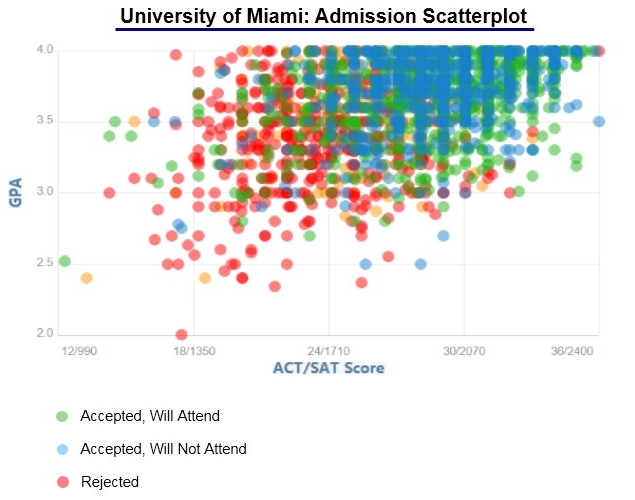
University of Miami is a highly competitive school and its admissions statistics make University of Miami one of the 50 most competitive schools for undergraduate admissions globally. Similar to the trends across all top schools, University of Miami acceptance rates have continued to decline over the past 8 years and will almost certainly continue to do so into the future.
For the Class of 2024, 36,380 students applied to University of Miami. Overall applications decreased by 5.5% over last year (2023 to 2024) from 38,500 to 36,380.
Founded in 1925, the University of Miami, in Florida is a research institution distributed across multiple campuses. The Coral Gables campus has two colleges and seven schools; the Leonard M. Miller School of Medicine campus has three university-owned hospitals; the Rosenstiel School of Marine and Atmospheric Science campus is an eighteen-acre waterfront campus in Biscayne Bay; and the Richmond Facility is a seventy-six-acre campus used for atmospheric research for such things as Tropical Advanced Remote Sensing (CSTARS) and satellite operations research.
Florida is known for its unique wildlife and reserves. As such, the state provides the University of Miami with the ideal location for the study of marine science. The Rosenstiel School of Marine and Atmospheric Science has become one of the world’s leading academic oceanographic and atmospheric research institutions. With both basic and applied research interests, the school covers virtually all marine-related sciences. One such notable University of Miami alumnae in the area is Reuben Lasker, a fisheries scientist known for his contributions to larval ecology, particularly the Stable Ocean Hypothesis.
The University of Miami has a student population of approximately 16,172, with 10,590 of those being undergraduates. Nearly half of all undergraduate classes have seventeen students or fewer and each year the University of Miami awards thousands of degrees from its 115 bachelor degree programs. The university also awards about 1,045 masters degrees from their 104 master’s degree programs and 750 degrees from its J.D., M.D., and Ph.D. programs.
The University of Miami Libraries contains 3.5 million volumes, including more than 93,500 electronic journals, 703,000 electronic books, more than 4 million microforms, and 176,650 other forms of multimedia. The university is currently focused on expanding its digitized documents and images collections which currently totals more than 962,500 items.
Approximately 4,150 enrolled students live on campus, a vast majority of them being new freshmen who tend to enjoy popular UM sports such as men’s and women’s baseball, basketball, cross country, football, indoor track and field, and outdoor track and field.
UNIVERSITY OF MIAMI: CURRENT STUDENT POPULATION
Total Enrollment 16,068
Undergrad Enrollment 10,237
Freshmen not reported
% Male/Female 49% / 51%
% From Out of State 52%
% Freshman from Public High School 62%
% Undergrads Live on Campus 39%
% African American 7%
% Asian 6%
% Caucasian 44%
% Hispanic 23%
% Native American <1%
% Mixed (2+ Ethnicities) 2%
% International 12%
# of Countries Represented 113
UNIVERSITY OF MIAMI: FRESHMAN STUDENT PROFILE
Range SAT Critical Reading 600-700
Range SAT Math 630-720
Range SAT Writing 590-690
Range ACT Composite 28-32
Minimum Paper TOEFL 550
Minimum Web-based TOEFL 80
% Graduated Top 10% of Class 69%
% Graduated Top 25% of Class 90%
% Graduated Top 50% of Class 96%
UNIVERSITY OF MIAMI: ACADEMICS
Academic Rating 81
% Students Returning for Sophomore Year 91%
% Students Graduating within 4 Years 70%
% Students Graduating within 6 Years 81%
Calendar System Semester
Student/Faculty Ratio 11:1
Professor’s ‘Interesting’ Rating 76%
Professor’s ‘Accessible’ Rating 76%
Most classes have 10-19 students.
Most lab/discussion sessions have 10-19 students
UNIVERSITY OF MIAMI: MOST POPULAR MAJORS
Biological
Psychology
Finance








